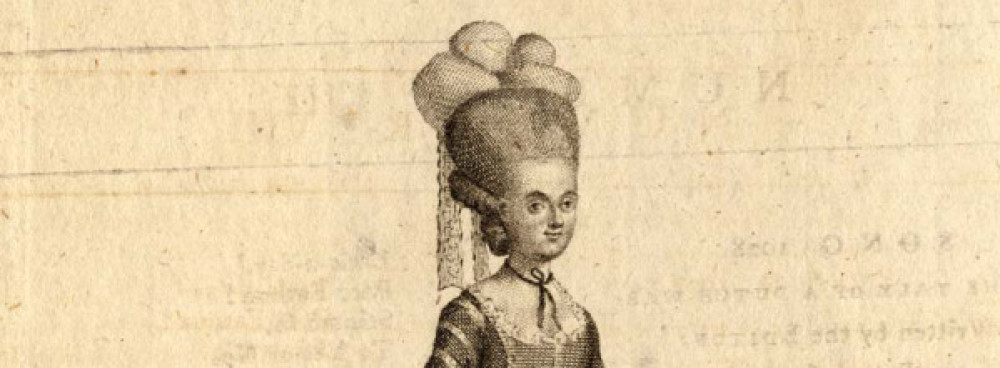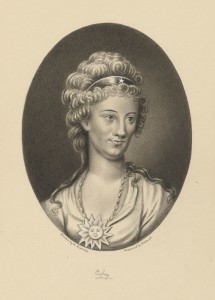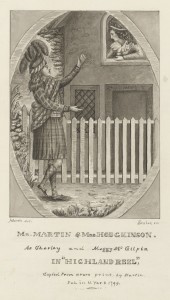Another member of the New York company was Mrs. John Hodgkinson, the former Frances Brett, daughter of renowned singer James Brett of Covent Garden and the Haymarket.
She married actor John Hodgkinson, who became a famous leading man on the American stage, although his “private life left much to be desired.”[i] He first eloped with the wife of his manager Munden, and she lived with him at Bath. At Bath, the New York theatre manager Mr. Henry engaged Hodgkinson for New York along with Miss Brett of the Bath Theatre, who ”later became Mrs. Hodgkinson.”[ii] Seilhamer maintains that ‘Hodgkinson “’repudiat[ed] the woman who bore his name at Bath, so that another woman might bear it in America.’”[iii] The Hodgkinsons were recruited by Mr. Henry of the Old American Company in New York and arrived with Mrs. Pownall in 1792.[iv]
Miss Brett, later Mrs. Hodgkinson, was young, attractive, and talented:
She was very fair with blue eyes and yellow hair approaching to the flaxen. Her nose was prominent or Roman; her visage oval and rather long for her stature, which was below the middling. Her general carriage on the stage was well suited to the character she performed; and in romps, full of archness, playfulness and girlish simplicity. As a general actress, she was as valuable in female as her husband was in male characters.’”[v]
Mrs. Hodgkinson was particularly effective in sprightly roles, and she became a favorite with New York audiences. The Daily Advertiser of January 1800 reported, “We feel particular pleasure in noticing this favorite of the laughter loving wife. In youthful characters of the comic cast, Mrs. H. stands unrivalled. She possesses a general ease and sprightliness which gives vivacity to parts . . . .”[vi] Although Mrs. Hodgkinson did perform roles that were non-singing, her vocal talent and her comic ability were considered her strengths. Although one newspaper claimed that her portrayal of Ophelia in Hamlet was “unrivaled,” another maintained that he when she left “the comedy for the higher walks of the drama,” she met with inferior success.”[vii]
Of all of the other actresses, Mrs. Hodgkinson was the only one who was overshadowed by her husband. She performed with him, and he negotiated on her behalf. Together they played in New York and then for a season at Boston, before returning to the New York Theatre.
Mrs. Hodgkinson continued to perform even when her health deteriorated. Dunlap records that in June, “she appeared so unwell when playing …that the manager spoke to her husband on the subject…:” Mr. Hodgkinson, according to Dunlap, reported that his wife ‘could not sing, but could do any speaking part.’” On June 26th, 1802, she appeared in The Stranger, “looking so as to make the writer’s heart ache.” Dunlap reports that Mrs. Hodgkinson said that “she could play no more” and gave the impression that “she had been compelled to play.”[viii]
Mrs. Hodgkinson died of tuberculosis on September 27, 1803.[ix] She was buried in St. John’s Burial Ground in New York City, which was razed at the end of the nineteenth century to create the James J. Walker park.[x] The inscription on her monument, however, had been published in several newspapers, including two articles in The New York Times:
Sacred to the memory of Mrs. Frances Hodgkinson who died September 27, 1803 aged thirty-two years.
More worth and virtue no’er adorned a breast
than dwelt in her’s, who now lies here at rest;
A tender mother and a faithful wife,
She passed adored through every path of life;
Her infant children feel the chastening rod.
Her husband yields an angel to his God.[xi]
Notes:
[i] Hornblow, 190.
[ii] Hornblow, 191.
[iii] Seilhamer, 191.
[iv] Ireland, I, 94.
[v] Dunlap, History, 192.
[vi] The Daily Advertiser, 16 January, 1800.
[vii] Commercial Advertiser (New York) 1 January 1800. The Daily Advertiser, 16 January, 1800.
[viii] Dunlap, History, 192-3.
[ix] Ibid.
[x] The front page of The New York Times , 13 September 1896, informs readers that if they wish to move their deceased loved ones from St. Johns, they must do so before November 15, 1896, when the conversion of the burial ground would begin.
[xi] “Where Actors are Buried: The Resting Places of the Veterans of our Stage, New York Times, 30 August, 1874. ProQuest Historical Newspapers. The epitaph also is recroded in The New York Times article of September 13, 1896, entitled “Old St. John’s Cemetery.”


